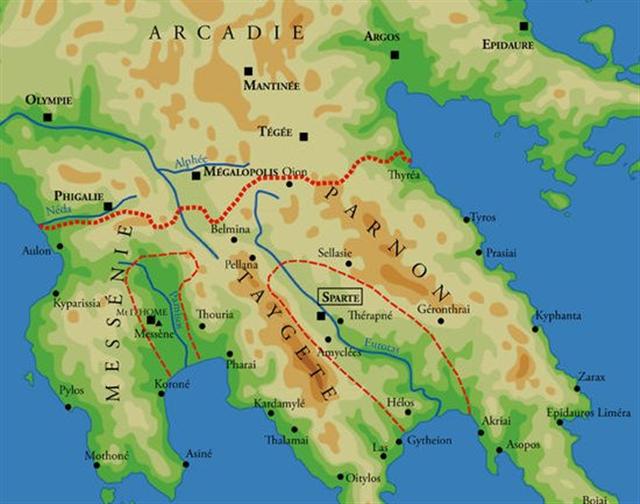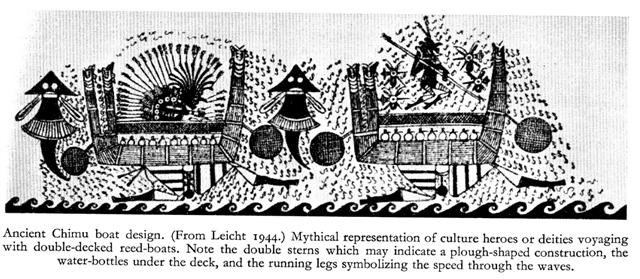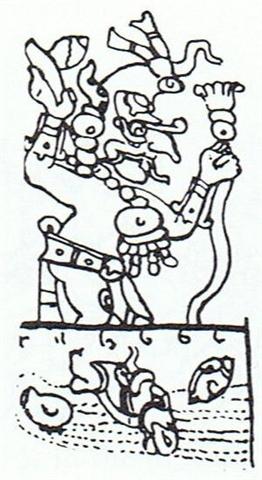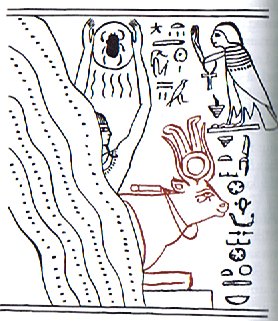After Nonoma (Jupiter) had gone out to urinate in the night, and then he ran to the ravine ('Eurotas') where he perceived the twin ship was arriving - and this was in October 15 and 80 days later than when the Sun had reached the place in the sky where Leo urinated.
The Gregorian calendar began 11 days after the northern winter solstice and at the time of the Bull - it could be reconstructed - the northern autumn equinox would have been around SEPTEMBER 22 (*185) when the Sun had reached Antares. This was where the Sun would have been in the middle (wasat) on his way down to the southern half of the celestial 'gourd'.
This was where the Sun would have been in the ravine between the Parnon mountain in the northeast and the twin sister mountain Taygete in the southwest.
Consequently Manuscript E seems to have stated that "October 15 (288) corresponded to the middle place ('in the ravine'). SEPTEMBER 22 (265) + (64 - 41) = 288 (Tangaroa Uri 15). Since the time of the Bull this place had moved ahead with 64 - 41 = 23 precessional days in relation to the Sun calendar. At the time of the Bull it had been at the northern autumn equinox but 41 precessional days before the time of rongorongo, at the time of Bharani (the place for birth), it had moved to heliacal Antares. This was where the reincarnated spirit of the Sun would have descended from above, from the northern hemisphere. ... The branches with their white flowers bent down along their thighs, the double-headed ecliptic snake rested in their arms, and the great bird Itzam-Yeh stood on their head. I already knew as I stood under the young tree in Tikal that the kings were the human embodiment of the ceiba as the central axis of the world. As I stood there gazing at the flowers in Joyce's hand, I also learned that the kings embodied the ceiba at the moment it flowers to yield the sak-nik-nal, the 'white flowers', that are the souls of human beings. As the trees flowers to reproduce itself, so the kings flowered to reproduce the world ... 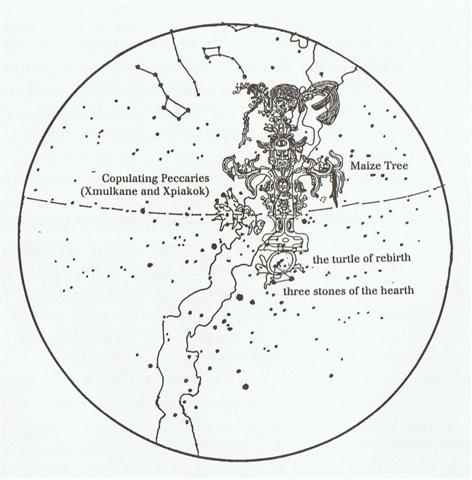 But the Gregorian calendar had its midpoint at heliacal Sirius. From January 1 to 0h there were 80 days and therefore day 288 (= 208 + 80) could be regarded as the mirror image of 0h at the opposite side of the year. It was necessary to adjust from the Gregorian calendar to a calendar oriented from where the Sun would arrive, oriented from spring equinox where he was running quickly like a river in a ravine, instead of standing like a tree rooted in the ground and hardly move at all.
The waves which are illustrated under the pair of Chimu ships above will make us understand that they are described as upside down where the Rain God was using his flint hammer in order to recover the force of life. ... 'By striking the anvil,' said Ogotemmêli, 'they get back from the earth some of the life-force they gave it. Their blows recover it.' But blows on the iron must be dealt by day. The smith's work is day labour, no doubt because the smithy fire, being a fragment of the sun, could not shine at night. That is why it is forbidden, not only for smiths but for everybody, to strike blows on iron or stone or earth in the night-time. No blow of hammer or tap of pestle should be heard, whether loud or soft, in the silent hours. To strike blows at night would destroy the effect of the blows struck by day. It would mean the rejection of all that had been gained, so that the smith would lose whatever he had recovered during the day of the life-force of which he formerly divested himself ... Manuscript E signaled (waved) this information: ... The canoes of Ava Rei Pua and of Hotu were seen near the (off-shore) islets. On the fifteenth day of the month of October (tangaroa uri) the canoe of Hotu and the canoe of Ava Rei Pua landed. On the fifteenth day of the month of October (tangaroa uri), Nonoma left the house during the night to urinate outside. At this point Ira called out to Nonoma, 'Look at the canoe!' Nonoma ran, he quickly went to Te Hikinga Heru (a ravine in the side of the crater Rano Kau) and looked around. There he saw the double canoe way out near the (offshore) islets, and the two (hulls of the canoe) were lashed together. He ran and returned to the front of the house. He arrived and called into the house: 'Hey you! This canoe has arrived during the night without our noticing it!' Ira asked Nonoma, 'Where is the canoe, which you say is lying out there (in the water)?' Nonoma's voice came back: 'It is out there (in the water) close to the (offshore) islets! There it lies, and the two (hulls) are lashed together.' The four of them (corrected for 'the six of them') went out and picked up leaves (on branches) to give signals. They picked them up, went and arrived at Te Hikinga and saw the canoe. Raparenga got up, picked up the leaves, took them in his hands, and waved, waved, waved, waved. This was seen by the man who understood signals; he looked down and called out the following to the king: 'They are waving, they are signaling the following message: 'The land is bad, the shoots growing out of the ground cannot spread because the algae-like thicket is very long when it is pulled out, when it is ripped out!' (This means that the runners of the yam roots that were planted are unable to prevail against the heavy weeds, which have to be pulled out continually.) King Hotu called to Tuki, 'Sígnal and answer the following: The homeland is bad too, (because there) the flood brings destruction and the low tide brings relief (this is a reference to the losses caused in Hiva by the rising of the water, or rather, by the subsidence of the land.) (In the meantime) Ira and Nga Tavake had arrived. Tuki signaled and answered the message in this manner - he waved and waved. The signal arrived up (at the cliffs) where Raparenga was. He looked out and watched for it. Then the waving stopped (?). Ira asked, 'Why did they send signals?' Raparenga replied, 'Because we sent signals first'. Ira said, 'We have lost the bad news for you (which means, we have warned you in vain).' Ira said to Raparenga, 'Give signals and tell this: If the canoe continues to the right side (of Easter Island, seen from Motu Nui), they should sail way out because of Tama, an evil fish with a very long nose (this is a wordplay with the place name on the southeastern shore, which 'demands bad victims because of its cliffs').' He waved, waved, waved, waved. The ones on board the boat saw Raparenga's waving and understood. The signals arrived on board the canoe; the waving arrived below (i.e., in the west) ...
The name of the ravine was Hikinga Heru, a name beginning with hiki-ga = the place (-ga) for elevating: ... The brothers of Maui sat trembling in the middle of the canoe, fearing for their lives. For now the water was frothing and heaving, and great hot bubbles were coming up, and steam, and Maui was chanting the incantation called Hiki, which makes heavy weights light ...
|
||||||||||||||||||||||||||||||||||||||||||||||||||||||||||||||||||||||||||||||||||||||||||||||||||||||||||||||||||||||||||||||||






